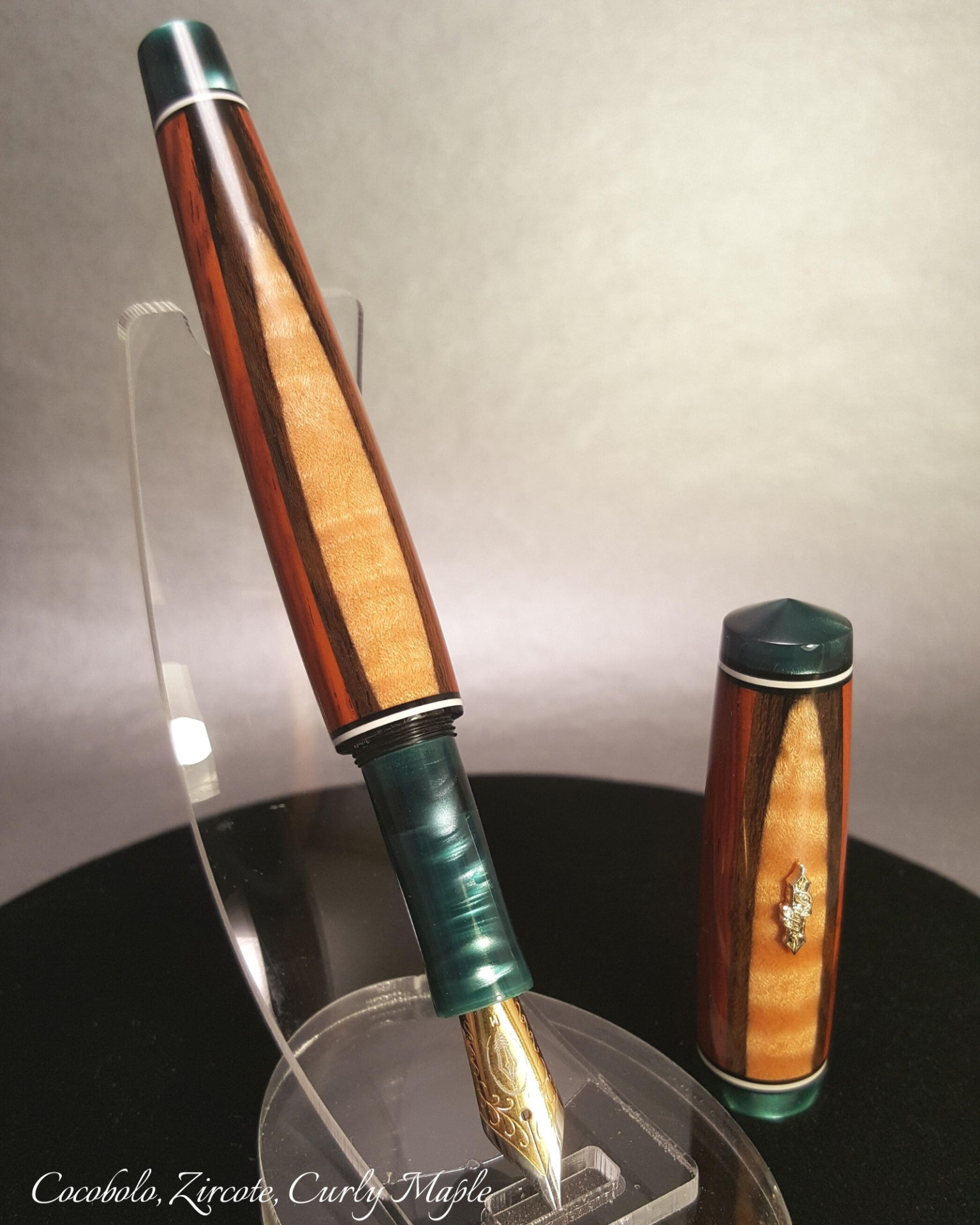
Michael Riggs of Riggs Premium Pens says “I don’t sell pens. I sell happiness” as he talks about his passion in an exclusive interview.
Michael Riggs grew up and currently lives on Long Island in NY. The neighbourhood where he lived during his childhood was somewhat rural at the time and within walking distance of a large mill pond where he spent a lot of time fishing and catching “critters”. He was quite involved in Scouting and went on to become an Eagle Scout, as did his 2 brothers. These activities gave him an appreciation and love for the beauty of the natural world. This is the reason he uses wood as the primary material for his pens.
Today Michael is a Research Technician in a molecular biology laboratory where they study the biochemistry of cancer. The work is exacting and requires precision and accuracy. He suspects that he has a level of OCD since he loves precision, a necessary quality for lab work and making fine writing instruments.
Michael says “I’m humbled by the response to my pens and I am honoured whenever anyone spends their hard-earned money on one. Especially considering all the other choices available”! Excerpts:
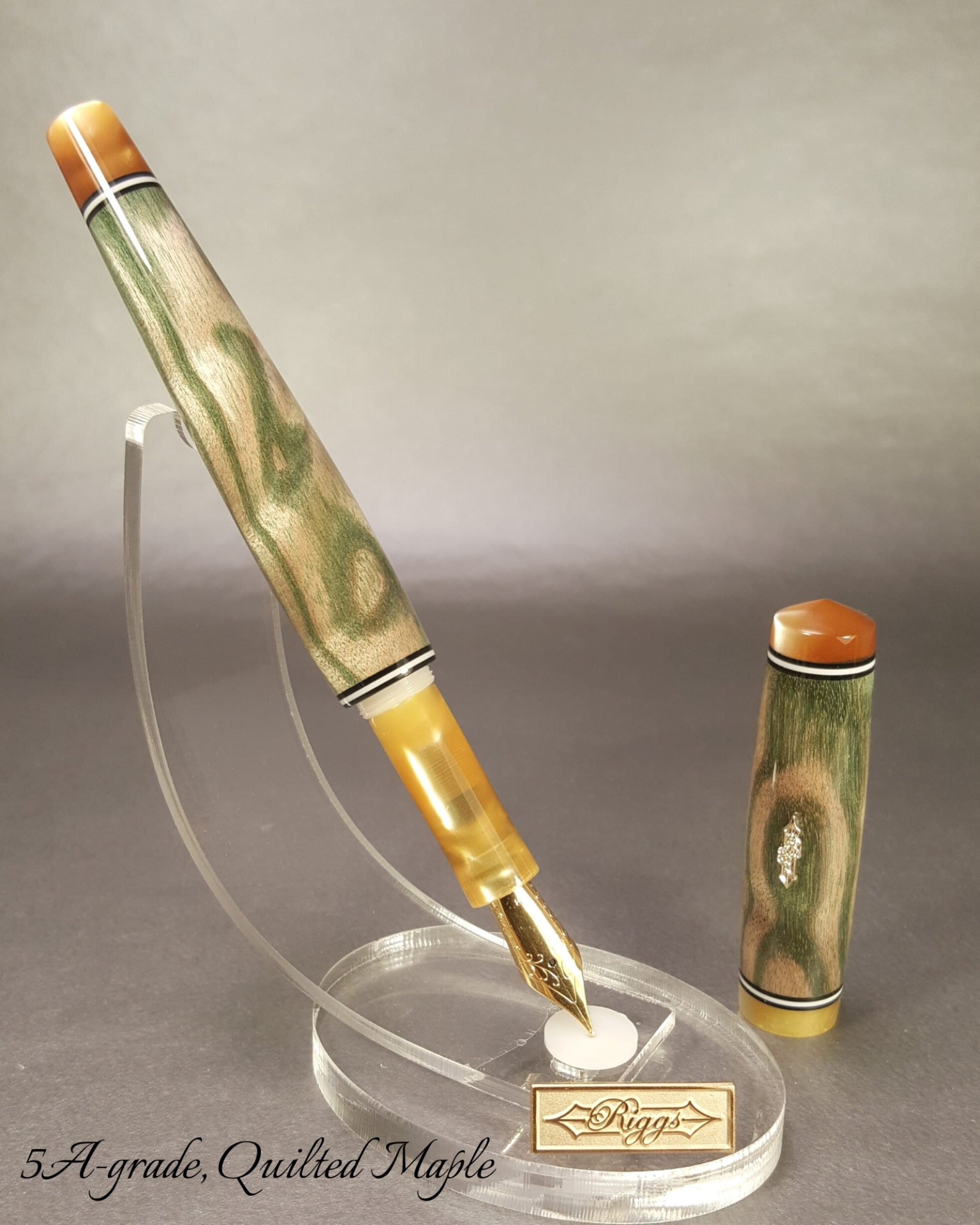
Inked Happiness: When did you take up pen turning as a commercial activity? What prompted you to get into this rather unconventional activity?
Michael Riggs: I turned my very first kit pen in the fall of 2018, less than 3 years ago. Woodworking has been a hobby of mine since I was a teenager, so I have quite a bit of experience using woodworking tools and finishing wood. But I found out quickly that crafting furniture one piece at a time was far too time consuming to be profitable when done part time. In browsing through my woodworking catalogs, I would always pass over the “pen-making” section. I regarded such an activity as a craft, something old men do to pass the time and stay out of their wives’ hair. Then one day I took a close look in the mirror and decided, “it’s time”.
I began with kit pens, but I only used the highest quality kits available and the most exquisite examples of wood I could find. It’s my habit to go “all in” whenever I take up something new. It wasn’t long before I had a substantial collection of these pens to show around. Right about then, a friend told me about a pen show coming up on the weekend here on Long Island. I had never been to a pen show before so I went with pen case in hand to check it out. The organizer of the show saw my case and asked to see my pens, so I proudly opened the case only to watch his face change when he saw they were kit pens. He acknowledged that my workmanship was excellent and the wood was incredible…but they were kit pens. I was surprised to learn that such pens are looked down upon by serious pen folks. The man told me that if I wanted to be a pen-maker and taken seriously, I had to develop my own design and it must be a fountain pen. I could tell by the look on his face that he didn’t expect in a million years that I would make that happen. It was that look on his face which has driven me to where I am now. Failure was not an option!
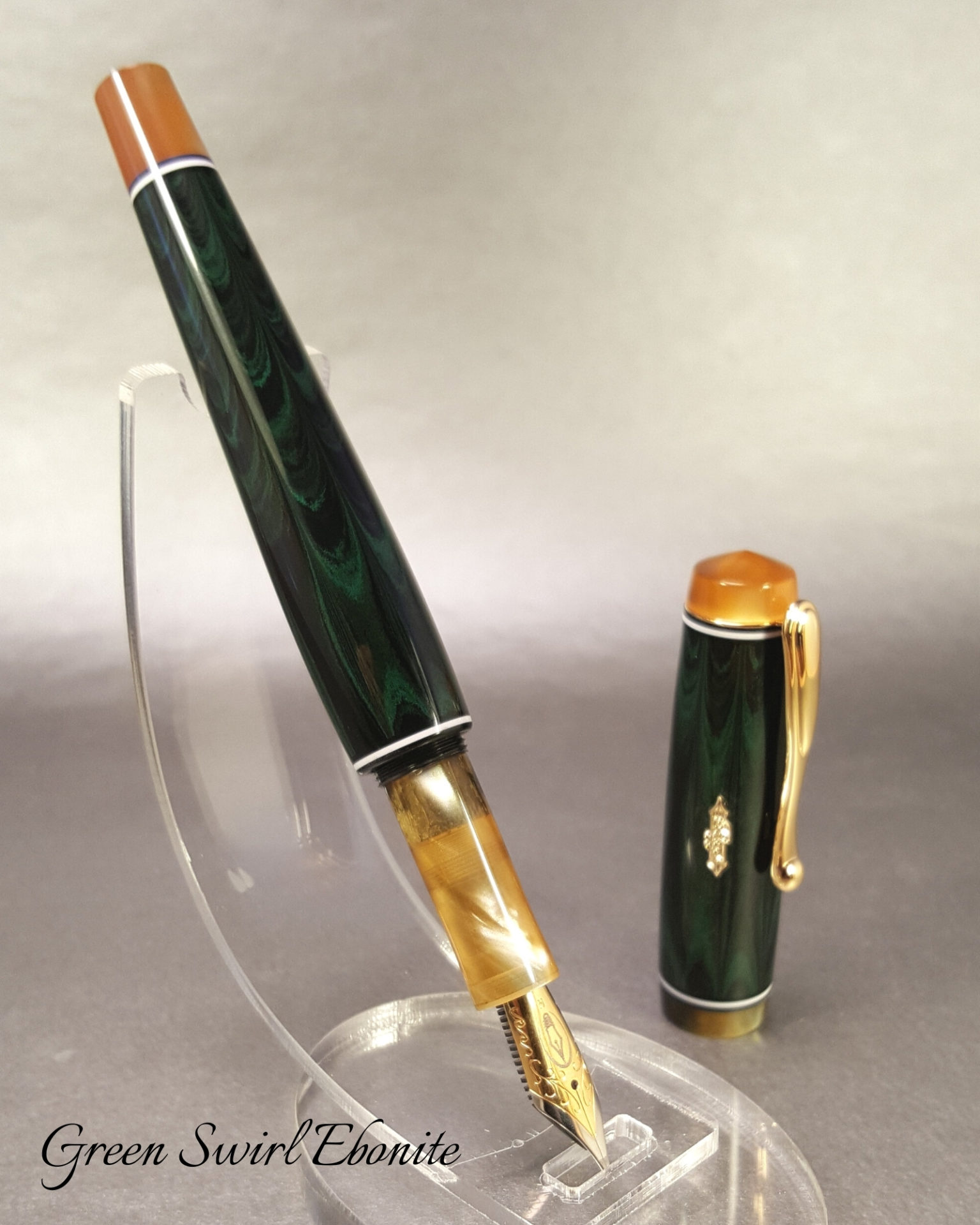
Inked Happiness: What were the major obstacles that you had to overcome to curve out your niche in the world of fountain pen turning? What advice do you have for people who want to get into the field?
Michael Riggs: The very first obstacle I faced was designing a fountain pen. I had never even used a fountain pen before. You may think that at the very least, I would have taken a look at what other fountain pens looked like. But instead, I went into my own head and considered what one looks like in my imagination. This was a benefit to my design since I wasn’t influenced by other designs. I put on blinders, remaining blissfully ignorant of what others were doing. I simply focused on what I was doing. Fortunately, I came up with a design which was not coincidentally similar to anyone else’s work. (as far as I know!). But I wasn’t even aware of how unique my design was until people began commenting on the originality of the design. A pleasant surprise!
My advice for people who want to get into the field is this… You can succeed if you want to badly enough. It will take persistence. If you’re not passionate about pen-making, the odds are slim that you’ll succeed. YouTube is a valuable resource. Mistakes will happen, don’t become discouraged by them. Improvement comes from correcting mistakes. Solve one problem at a time, whatever the problem is. Eventually there will be fewer and fewer problems. When you show your pens, ask people to tell you what’s wrong with them. It’s nice when you’re told your pens are beautiful, but that’s not helpful. Make the pen you’re working on now the best pen you’ve ever made. Even better than the last one! I think though, the most important bit of advice I have for anyone wishing to be a pen-maker is this… “Don’t make your pen look like mine”. LOL.
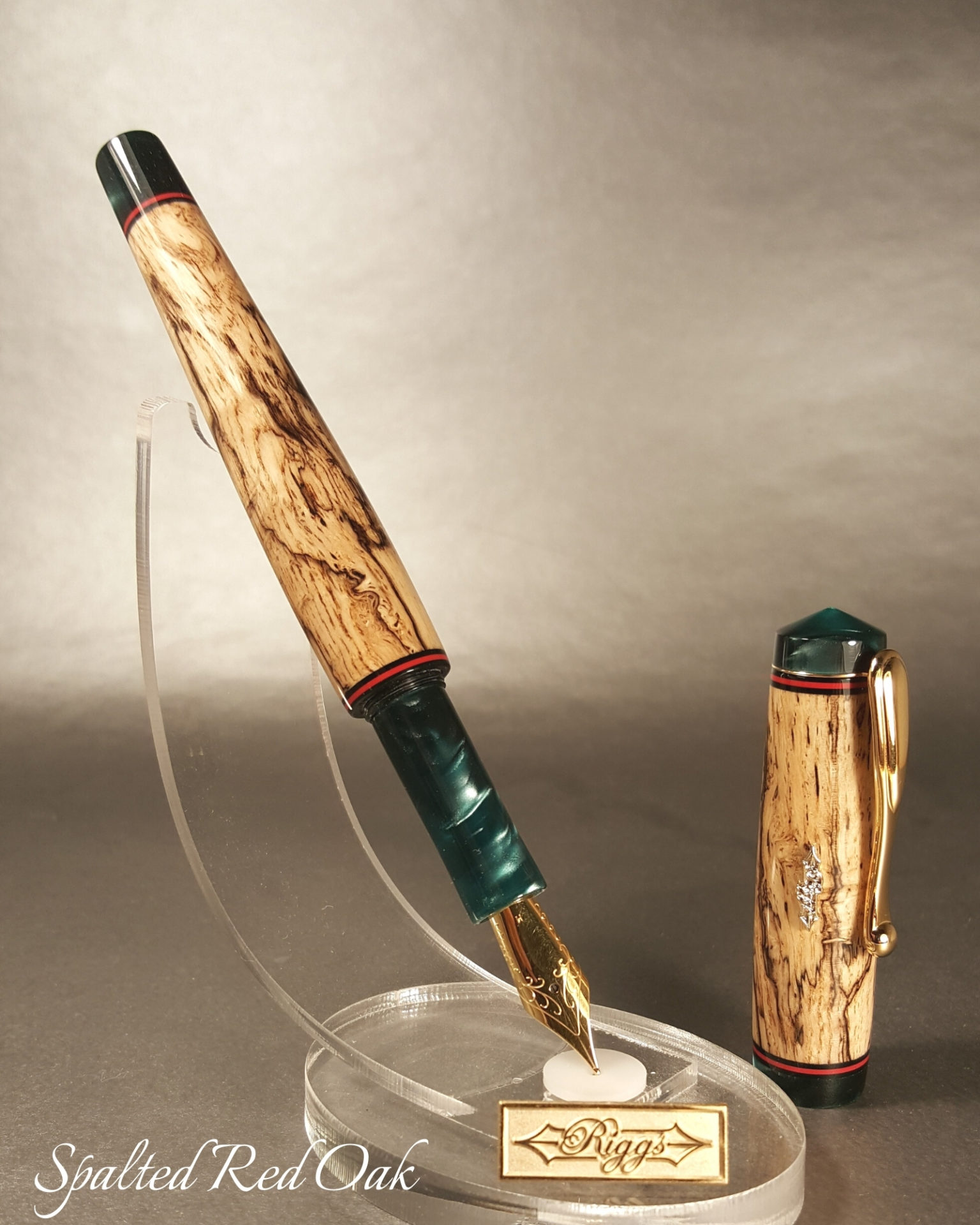
Inked Happiness: What is the USP of a hand turned bespoke creation from Riggs Pens?
Michael Riggs: I approach pen-making as an art. Each creation is an individual, utilitarian art piece. My pens are built around the JoWo #6 nib unit and universal type converter. This ensures a pleasurable writing experience. When you think about it, the rest of the pen is just a handle. You could stick the converter and nib into a potato and it will write just the same (although awkward to hold) but you understand what I mean. So, I spend a lot of time considering the area within a piece of wood I will use for maximum effect, the colour and style of acrylic for the finials and section and which type of banding to include. The whole pen must come together in a pleasing way. Most often my pens are inspired by a theme. The overall appearance of my pens is meant to remind the user of something beyond the pen itself. You’ll see that I name my pens as a clue to the theme I had in mind. However, it’s not unusual for people to see something different from my intent in a particular pen. I believe that is what art is meant to do. This is always a joy for me!
There are as many wonderful choices of lovely writing instruments as there are reasons for someone to purchase them. I would encourage everyone to purchase the pen which pleases them the most. If you’re interested in a pen which contains a part of the pen-maker’s soul, then a Riggs pen would be an excellent choice.
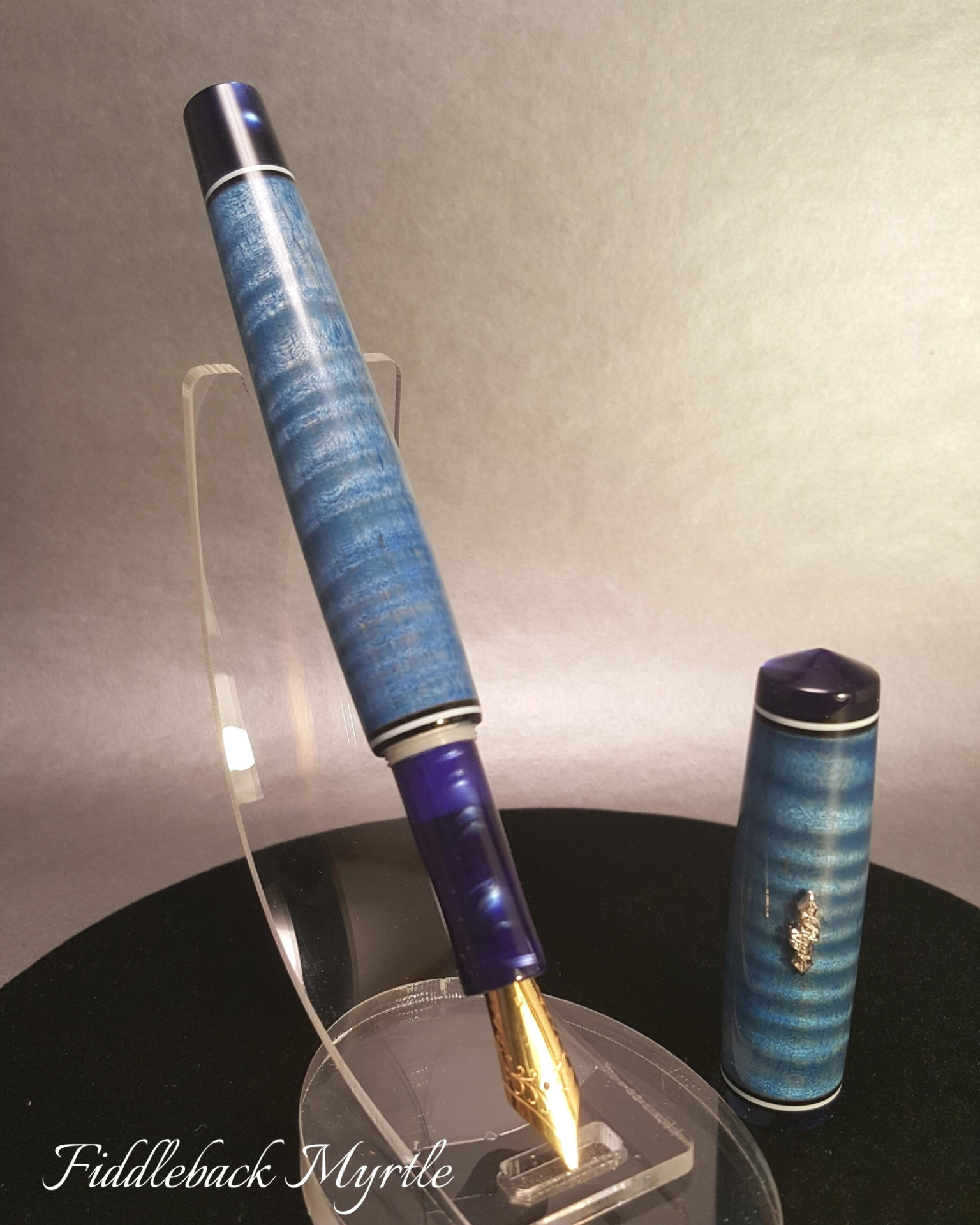
Inked Happiness: Wood and Ebonite are your chosen materials. Why? How difficult is it to create works of art with them? Between the two, which one is your favourite? Why?
Michael Riggs: Wood is the material I prefer. The variety of extraordinary colours, grains and textures is vast. If you consider the additional natural variations within any given species of wood, the palate of possibilities becomes almost endless. This ensures that every one of my pens is unique. No two pens will be exactly alike. Indeed, if someone asked for a pen just like another creation of mine that they have seen, it would be nearly impossible to duplicate. That said, I can make another one similar and just as beautiful, perhaps even more so. It’s my goal to make each pen my next personal best. In addition, I like to make pens which are “close to nature”, of a material borne of the earth. Wood fits that description nicely.
The ebonite pens I make came about from a request made by a patron. He asked me to make for him an ebonite pen made to his specifications. I had used ebonite in the past for tobacco pipe stems back when I was making handmade pipes (that’s another whole story entirely!), so I had some on hand. There are challenges with ebonite, it tends to come off the lathe tool in long strings which wind themselves around the work and need to be cleared often. This is quite a nuisance and distracts me from the rather Zen process of turning. However, ebonite has a unique warm feel in the hand and polishes to a lovely gloss. The final result was a pen which received a very positive response. So although I prefer wood, ebonite will always have a place in the Riggs line-up.
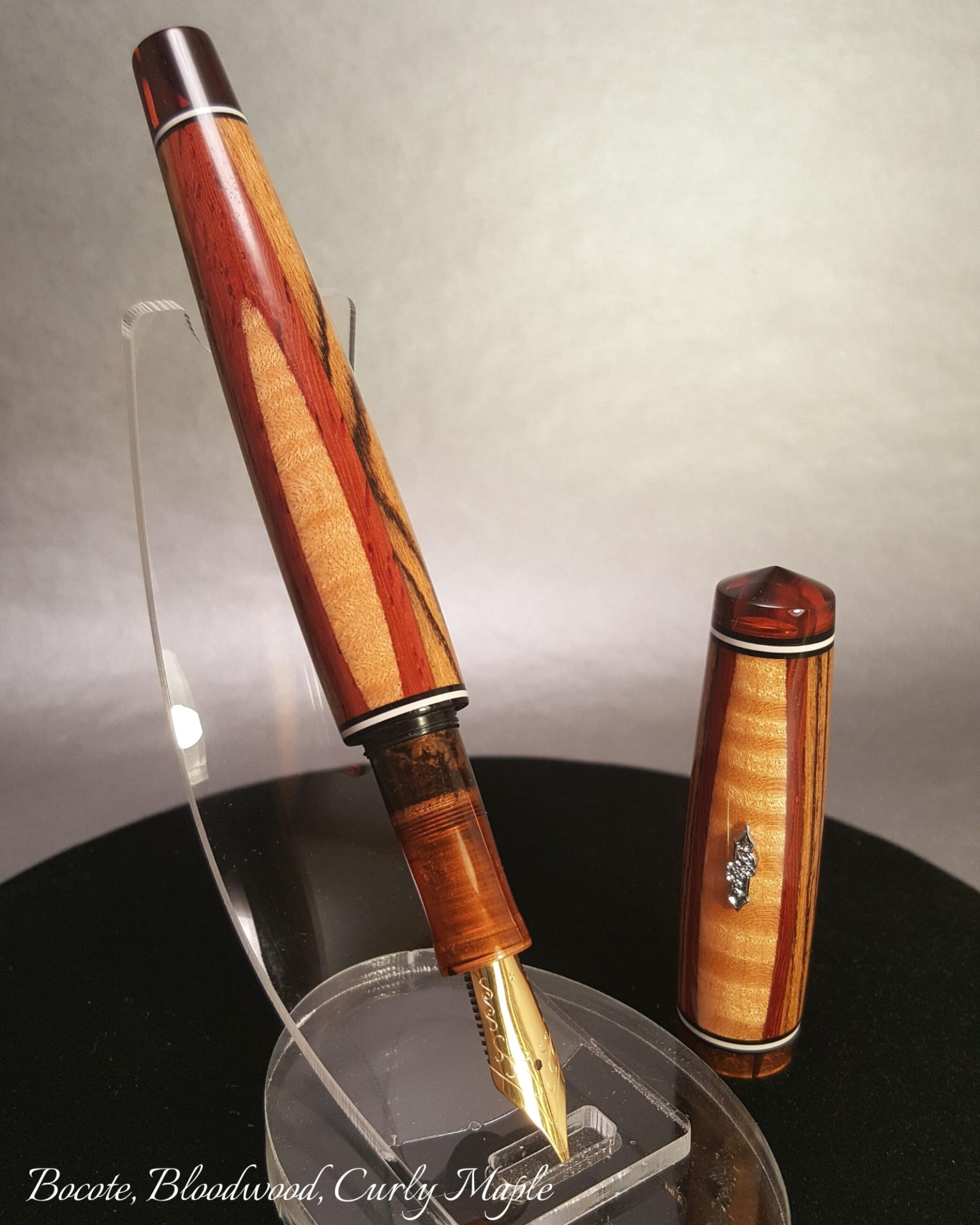
Inked Happiness: Why is the clip missing in most of your creations? Is it deliberate? A signature statement perhaps? Or is it because you intend your creations to be used more as desk pens as opposed to being carried on the self?
Michael Riggs: These questions have vexed me from the beginning. Allow me to put this to rest once and for all with complete honesty. The design of my pen is integral with its construction. The original design called for the cap and cap finial to be turned and finished as a single unit. For a long while, this made the addition of a clip impossible. At least until I had time to think about the problem long enough to overcome it. The ebonite pens don’t have a clear-coat finish on them, this removes some of the complication of construction for clip addition. My ebonite pens were the first Riggs pens to sport a clip. So in all honesty, (and this is difficult to admit), it was just too hard… there, I said it! There were other practical concerns as well. I sell very few pens compared to more established pen turners, so to have a clip manufactured for me would have required an enormous minimum order which was cost prohibitive. I could have fashioned some sort of clip from a strip of metal, but the high standards I have for the appearance of my pens would have been compromised.
So, what to do? I omitted the clip. I tell people it’s because I don’t want to distract from the beauty of the wood, but that’s only a half truth. It’s true, but not the whole truth. Recently I’ve developed techniques which will now allow me to add a clip to my wood pens. The first of which I unveiled last week. The process of adding a clip adds a significant amount of labour and consequently the price is higher for those pens. In an effort to keep my prices in an affordable range, the default Riggs pen will remain clipless. For those willing to pay extra, for now the clip adds $75 to the price. Personally, I like the clean, sleek look of the clipless Riggs pen and I know others do as well. For example, if you’re someone who carries a purse, you probably don’t keep your pen in a shirt or jacket pocket, so the clip is moot. I’d love to expound on some artsy reason for not having a clip but I’m afraid the actual reason is purely practical. But the clip does add a nice touch and some won’t purchase a pen without one. Bottom line… clips are available on custom orders for those who want one. BTW, there’s never an extra charge for a custom order… just for the clip addition.
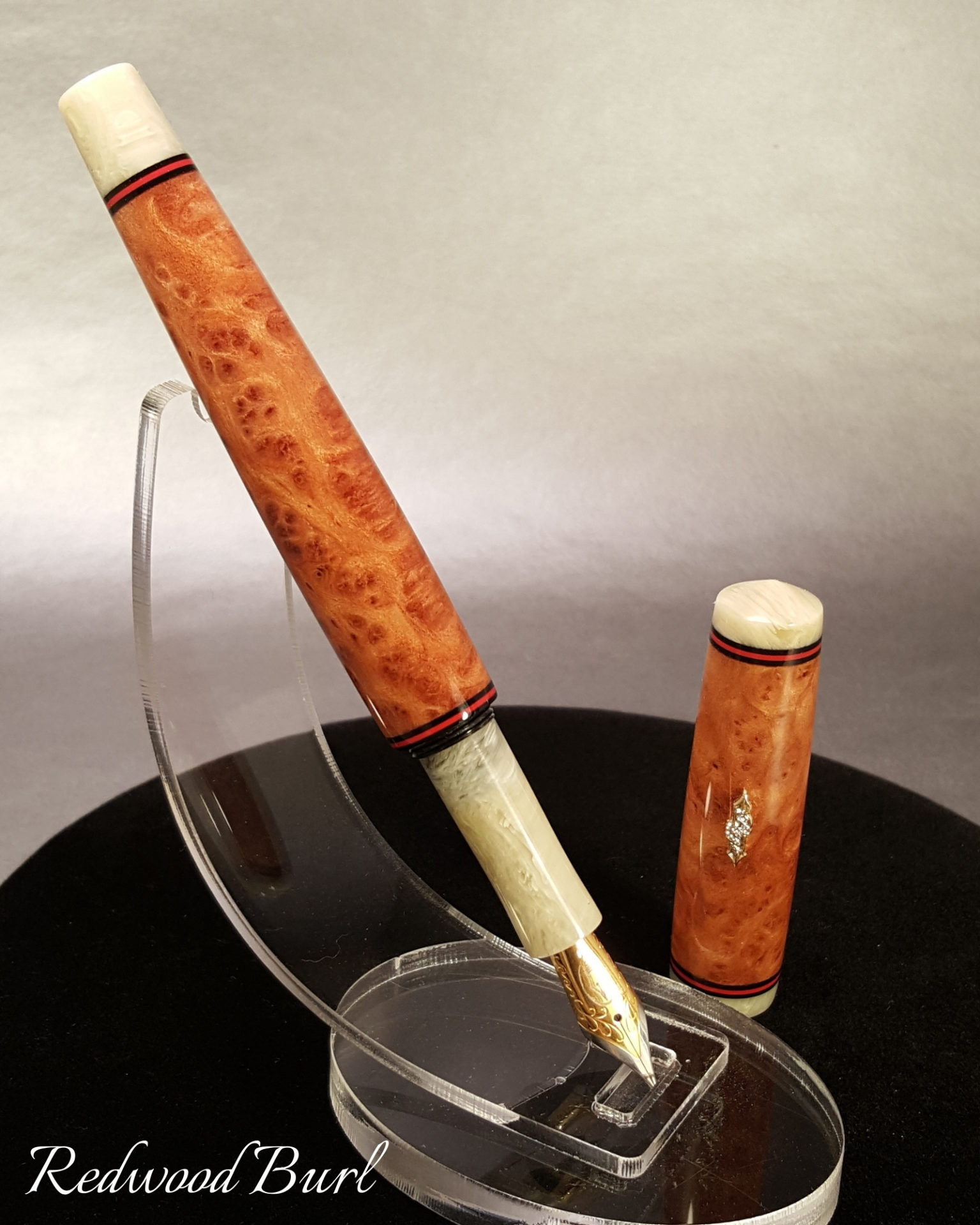
Inked Happiness: How has the pandemic impacted your business? Forced indoors, are people buying more pens? Do you see a revival of sorts with more people, especially young people picking up the fountain pens?
Michael Riggs: The pandemic has dragged me kicking and screaming into the world of social media. I’ve managed to avoid it for many years as a matter of principle. I was taught at a young age to value my privacy, so putting my whole life online is not something I was interested in doing. I enjoy face to face (or over the phone) human interaction. Before COVID shut the world down last year, I exhibited at the Philadelphia and Baltimore pen shows. There I met many lovely people who gave me great encouragement to develop my craft. The shows were the perfect venue to acquaint people with my work. Many people enjoyed hearing about the different woods and the story behind each pen. The human connection and the ability to experience my pens for themselves gave people the confidence to make a purchase… and purchase they did! I don’t like the notion that I am a salesman who “sells” pens. I prefer to think of myself as an ambassador who introduces you to my fountain pens. The silent and beautiful pen will take it from there!
With the cancellation of all remaining shows last year, my sales came to a grinding halt. This was no surprise as I’m a very recent newcomer to the pen world. I was left with no choice but to get on Facebook and do my best to present my work and get the word out. I’m fortunate in that when seen and held in the hand in person, the pens sell themselves. Although I’m able to present nice photos, the pens still look much better in person. This makes for very happy patrons…. IF, I make a sale. And there’s the rub. People work hard for their money. I fully understand their reluctance to purchase a pen from an unknown pen-maker and risk disappointment. Word of my work is slowly seeping out into the pen world. I’m pleased about that.
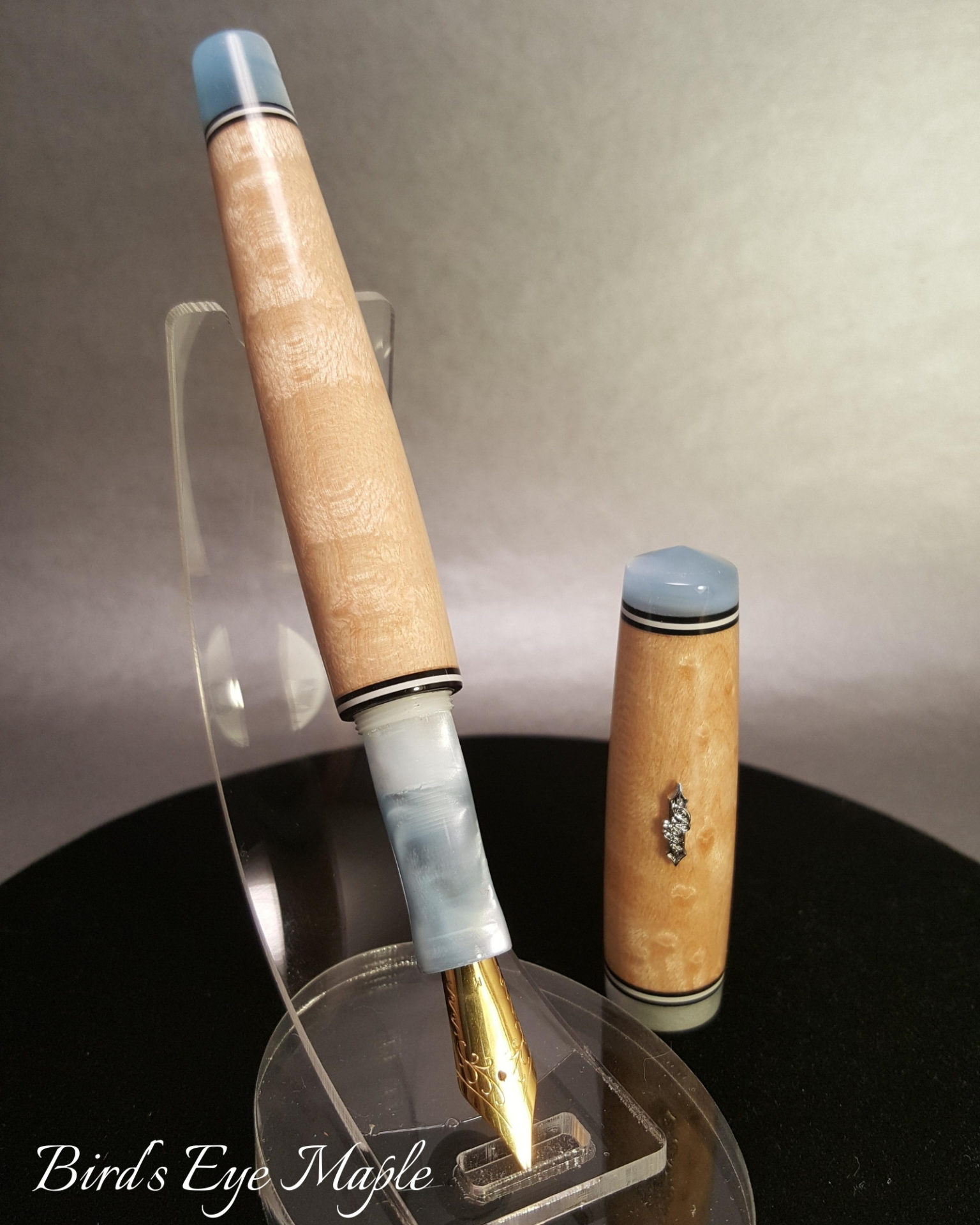
Inked Happiness: What are your plans for the future?
Michael Riggs: My plan is to retire from the lab in 3 years and begin crafting fountain pens full time. My wife and I would like to leave New York (who wouldn’t!) and settle someplace where I can have a larger, more organized workshop, some room to roam and a lake to fish in. I’m hoping by that time, word will have spread about my work and more people would do me the honour of purchasing a Riggs pen.
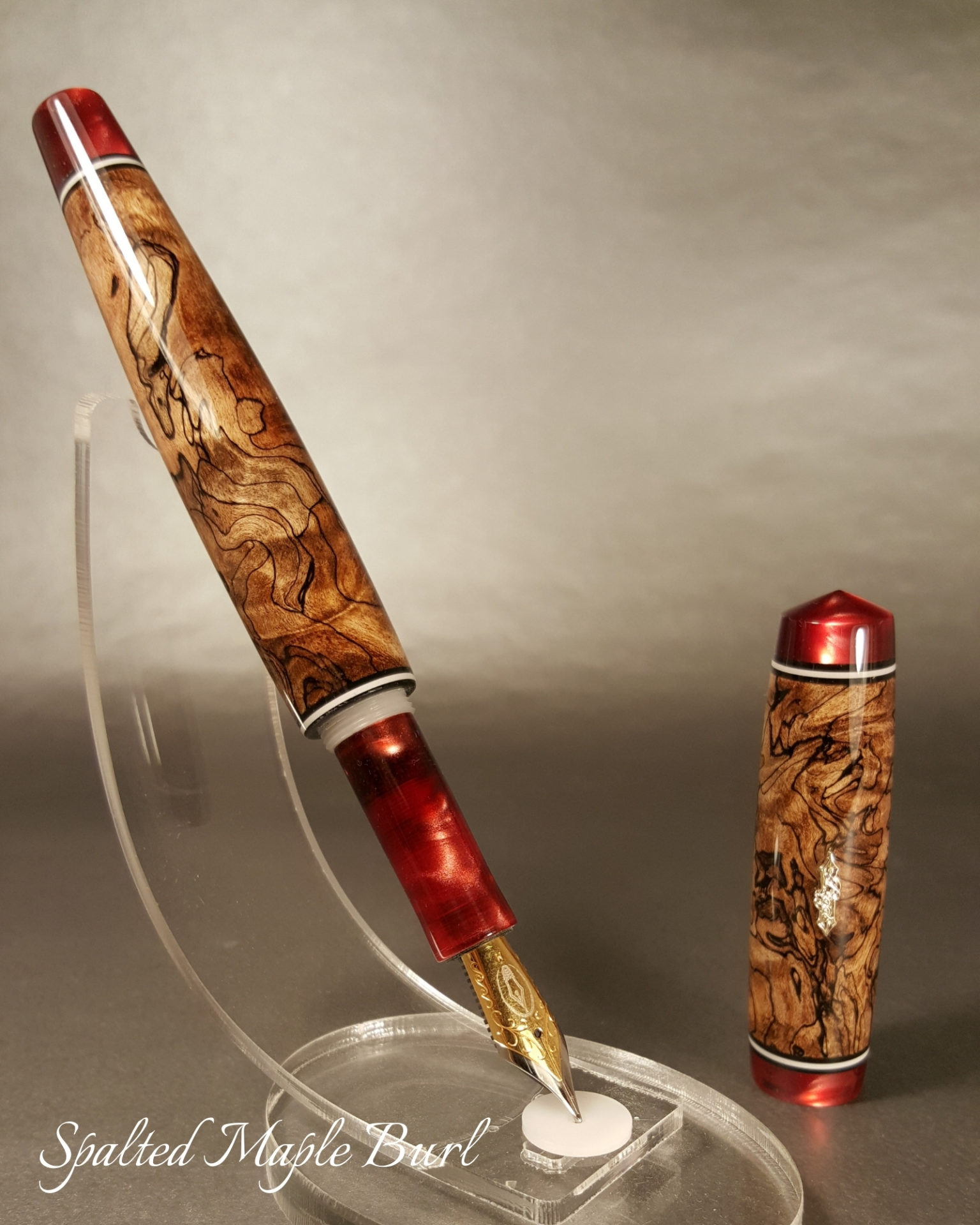
Inked Happiness: Anything that you would like to communicate to our readers.
Michael Riggs: I don’t sell pens. I sell happiness. My creations are merely the vehicle to accomplish that end. It is extremely gratifying for me when a patron’s pen arrives in the mail and they can’t wait to tell me how it has exceeded their expectations. I’ll need to ask a psychologist someday why this is so important to me!
For More information: http://riggspremiumpens.com/
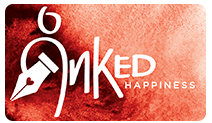
Michael Riggs produces extraordinary fountain pens. Thank You, Chawm, for highlighting his work in your usual, informative and interesting way!